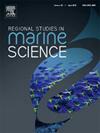利用被动声学监测评估鲸类和船只在迁徙通道内的重叠
IF 2.1
4区 环境科学与生态学
Q3 ECOLOGY
引用次数: 0
摘要
洄游的鲸类动物在夏天从觅食地迁徙到冬天的交配和产崽地,因此,它们需要付出巨大的努力来保护这些地方。然而,沿迁徙走廊的地区在鲸类生态中也起着重要作用,因为许多重要的活动发生在这些地区之间。这些中间区域的人为压力增加,需要评估鲸类栖息地的利用及其与人类活动的重叠程度。墨西哥加利福尼亚湾的塞拉尔沃海峡就是这样一个明显的例子。在这项研究中,在寒冷季节(2022年11月至2023年5月),每两个月进行一次被动声学监测,提供了有关该地区存在,饮食模式以及船只和鲸类重叠的信息。迁徙的蓝鲸、长须鲸、白头鲸、抹香鲸和海豚(飞燕科)也被发现。根据叫声的类型,研究人员发现,除了过境,蓝鲸还可能利用该地区繁殖和觅食。对于其他物种来说,进食、社交和繁殖等重要活动也在通道中进行。在200个 h记录中,血管在91 h被检测到,鲸类在80 h被检测到,两者在30 h被重叠。虽然在所有记录中有45.5% %的时间检测到血管,但重叠时间相对较低(15 %)。然而,鉴于该地区旅游活动的增加,建议进行持续监测,以确定对鲸类的潜在威胁。本文章由计算机程序翻译,如有差异,请以英文原文为准。
Cetaceans and vessels overlap assessment within a migration corridor using passive acoustic monitoring
Migratory cetaceans travel from feeding grounds in summer to mating and calving grounds in winter, and consequently, significant efforts are made to protect those grounds. However, areas along the migration corridors also play a significant role in cetacean ecology since many important activities occur in between those grounds. The increase of anthropogenic pressure in those intermediate areas creates the need to assess cetacean habitat use and overlap with human activities. The Cerralvo Channel in the Gulf of California, Mexico is a clear example of such areas. In this study, bimonthly passive acoustic monitoring during the cold season (November 2022 -May 2023) provided information on the presence, diel-pattern and vessel and cetacean overlap in the area. Migratory blue whales, fin whales, Bryde’s whales, sperm whales and dolphins (Delphinidae) were detected. Based on the type of calls it was found that besides transit, blue whales might also use the area for breeding and feeding. For the other species, important activities such as feeding, socializing and probably breeding also take place in the channel. Out of 200 h recordings, vessels were detected during 91 h, cetaceans during 80 h, and both overlapped during 30 h. Although vessels were detected for 45.5 % of the time of all recordings, the overlap time was relatively low (15 %). However, given the increase in tourist activities in the area, continuous monitoring is recommended to identify potential threats to cetaceans.
求助全文
通过发布文献求助,成功后即可免费获取论文全文。
去求助
来源期刊

Regional Studies in Marine Science
Agricultural and Biological Sciences-Ecology, Evolution, Behavior and Systematics
CiteScore
3.90
自引率
4.80%
发文量
336
审稿时长
69 days
期刊介绍:
REGIONAL STUDIES IN MARINE SCIENCE will publish scientifically sound papers on regional aspects of maritime and marine resources in estuaries, coastal zones, continental shelf, the seas and oceans.
 求助内容:
求助内容: 应助结果提醒方式:
应助结果提醒方式:


